Large Signed Vintage Highwaymen Painting By Highwaymen Artist R. A. McLendon
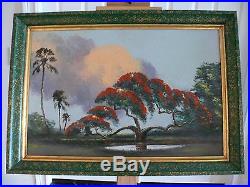
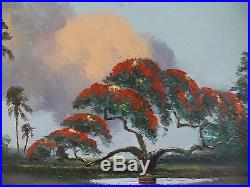
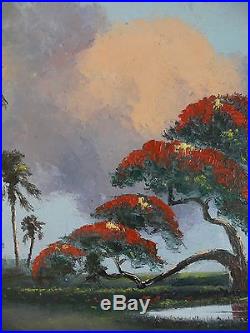
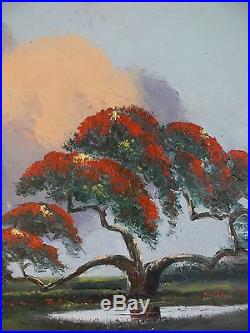
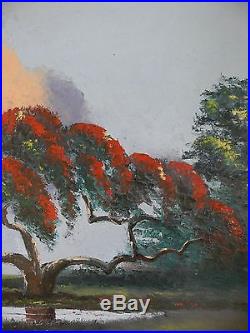
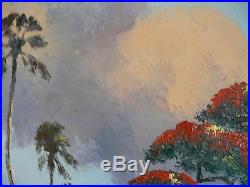
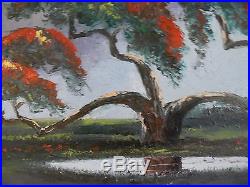
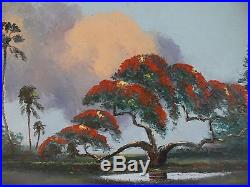
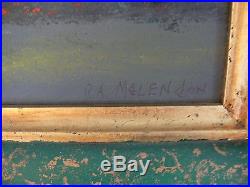


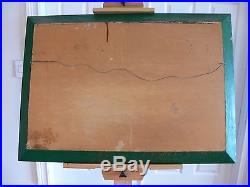

The board measures 36 inches wide by 24 inches high framed in a wooden frame to a dimension of 41 inches wide by 29 inches high. It is signed on the front R. The painting is intact without damage and in great condition. The back of the painting bottom left as seen in(photo # 11)shows some discoloration to the Upson board but the board is intact and sturdy.
As you can see the board is nailed to the frame without any distress see(photo #12). I have owned this painting for 25 years it has hung out of direct sunlight in a smoke free, pet free, temperature controlled environment. The daughter of the estate said she believed her parents bought the painting in the late 60's early 70's when they first moved to Florida. Below is a biography of R. McLendon taken from the Highwaymen Trail website. He was born in Pelham, Georgia in 1932, to a sharecropping family.There were fourteen children in his family, twelve boys and two girls. Roy had a twin bother, Troy Aljin, who died in his late 70s.
When Roy was young, the family moved to Delray Beach, Florida, where they raised peanuts and cotton. They later moved to Fort Pierce but traveled around the country as migrant workers, picking peas and whatever else was in season. Roy knows a lot about picking peas since they played such a major part of his work life. He explains that there are several rounds of picking field peas.In the first round, peas are plentiful and it is easy to get 40 bushels (there are 25 pounds to a bushel) in a day or more. The second round is harder and the third round is called scraps, which are the last few peas of the season. His experience working on the Belle Glade muck farms was especially difficult.
Roy describes the black mud as awful; it stings your skin and makes you feel like youre on fire. Farmworkers who worked the muck fields were identified with the derogatory term, muck steppers. Although migratory farm life was tough, it produced a rich culture that contributed to the character of black folklife in the South.
Roy worked the fields so often as a child that he left school sometime around the 9. Grade; it was hard to keep regular attendance during picking season.
He left home at the age of 18 and worked a variety of jobs including dishwashing, construction, and cutting trees. He spent time in a canning factory where he processed vegetables and pumpkins. Many of his jobs required great strength. Although he was small, he had sturdy legs and strong arms and could handle the heavy physical demands of hard labor.Roy eventually settled in Gifford, the African American section of Vero Beach. In the late 1950s, he met his neighbor, Harold Newton. McLendon explains, I would go outside and see him with boards tacked up on the side of his house, painting. Inspired, Roy began painting as well; like Harold, he wanted to make quality paintings. He had always enjoyed drawing, and took pride in what he created.
But he had to make a living, so he took other jobs like building walls along the ocean and laying terrazzo tile floors, most anything that paid the bills. He painted in the evenings and on days off. In his early 20s, Roy married Annabelle, who was four years older. They met when they were picking peas in New Jersey, and Roy noticed that she was a fast worker, especially for a woman. He remembers that she had a sister who was even faster at picking peas. He was so impressed by her abilities that one day he challenged her to see who could pick more peas in a designated amount of time. He beat her that day, but it was a challenge. Roy and Annabelle are still married; together they have eight children, two boys and six girls. As Roy continued to paint, his work got better. Harold Newton noticed his progress and encouraged him to take a few of his landscapes to an antique shop to sell. Encouraged by his good fortune, he stopped working other jobs and focused full time on his paintings. It was the mid-1960s and his career as an artist was taking off. One day Hair showed him some photos of cars and asked Roy which one he liked. So they painted around the clock at Alfreds house, one full day and night. That was the first and only time Roy painted with Alfred, as his painting process was not to Roys liking. Still, they spent a lot of time together. Alfred often came to Roys house for breakfast. They liked to go to the Rainbow Club in Eatonville, the historic black township and home of Zora Neale Hurston. When they left there, theyd go to the dog track and place bets. Once he was earning a good living, Roy established a schedule. He liked to paint in the mornings and then go to Jai-Alai fronton in the afternoons for the dog races. For Roy, Vero Beach, just over the railroad tracks from Gifford, was the most difficult place to make a sale. It was a Sundown town, meaning that black people were not allowed to be there after dark. There were many other ways in which racism played a part in his early years. He remembers that if blacks wanted to see a movie, they had to sit in the balcony.They couldnt talk or laugh out loud, and when the film was over, Roy says you had to run for your life because whites would throw sticks and stones at you. He remembers that one time his brother, who was a bit mentally challenged, couldnt keep quiet during a western. When a cowboy was poised to shoot someone in the back, he screamed, turn around, turn around, hes going to shoot you. He was removed from the theatre for that outburst. Roy also remembers that black men couldnt wear cowboy hats; it was against the law.
If he wanted a new pair of shoes, like all black people, hed have to go to the back door of the shoe store to get them. If you asked for a size ten and all they had was a size nine, you had to take it. Whatever the clerk wanted to give you, you had to take.
Roys paintings provided him with a different experience. He was recognized as being talented and he could (at least briefly) be welcomed in a white neighborhood.He never had an art lesson, but like other members of his family, he could draw. He sometimes visited Bean Backus at his house with Alfred and Harold and admired his talent. But Backus didnt teach Roy how to paint.
Besides, in Roys eyes, Harold was just as good as Backus and sometimes better. The item "Large Signed Vintage Highwaymen Painting By Highwaymen Artist R. McLendon" is in sale since Saturday, January 28, 2017. This item is in the category "Art\Art from Dealers & Resellers\Paintings". The seller is "member0112463" and is located in Satellite Beach, Florida.This item can be shipped to United States, to United Kingdom, DK, RO, SK, BG, CZ, FI, HU, LV, LT, MT, EE, to Australia, GR, PT, CY, SI, to Japan, SE, KR, ID, ZA, to Belgium, to France, to Hong Kong, to Ireland, to Netherlands, PL, to Spain, to Italy, to Germany, to Austria, IL, to Mexico, to New Zealand, SG, NO, SA, UA, AE, QA, BH, HR, MY, PA, JM, BB, BD, BM, BN, BO, EC, EG, GF, GG, GI, GP, IS, JE, JO, KH, KY, LI, LK, LU, MC, MO, MQ, MV, NI, OM, PE, PK, PY, RE.
- Original/Reproduction: Original
- Listed By: Dealer or Reseller
- Signed?: Signed
- Medium: Oil
- Subject: Florida landscape
- Style: Folk Art, Impressionism,
- Size Type/Largest Dimension: Large (Greater than 30in.)
- Region of Origin: US
- Artist: R.
